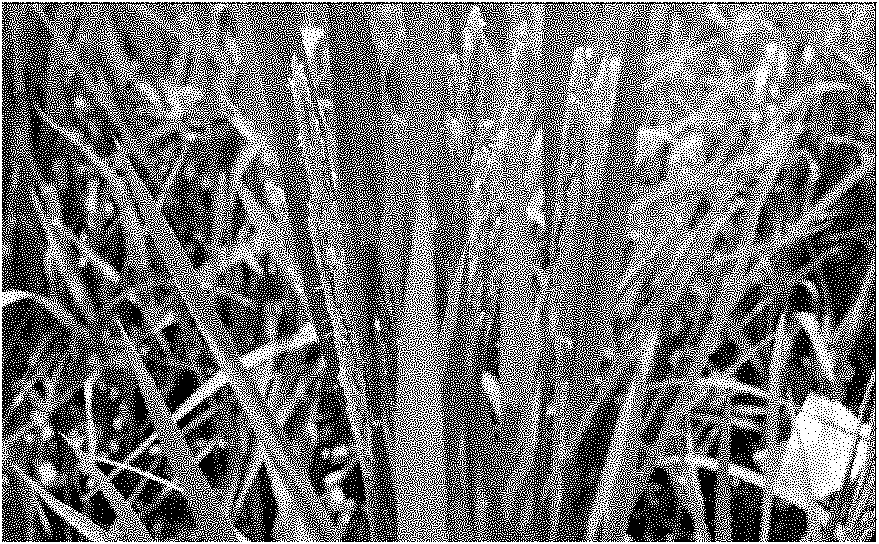Efficient technical system for creating wide compatible rice recessive nucleic sterile line
A technique of recessive sterility and broad parenting, which is applied in the determination/testing of microorganisms, biochemical equipment and methods, etc., can solve the problems of less markers, high cost, non-co-separation of markers and genes, etc., and speed up the breeding process , reduce the number of backcrossing, improve the effect of selection efficiency
- Summary
- Abstract
- Description
- Claims
- Application Information
AI Technical Summary
Problems solved by technology
Method used
Image
Examples
Embodiment 1
[0033] Example 1: Construction of a rice mutant library and screening of rice nuclear recessive sterile mutants
[0034] Create a rice mutant library and screen out rice nuclear recessive male sterile mutants ms26 , the mutant is homozygous at the mutation site. attached Figure 1A nuclear recessive sterile mutant in rice ms26 Morphological manifestations of rice spikes and flower organs of plants. attached Figure 1B shows the rice ms26 Pollen cannot be formed on the mutant plants.
[0035] wild type allele MS26 Compared to the mutant allele ms26 3102 bases were missing. The genotype of the locus can be determined by designing PCR primers to amplify the two by using the nucleotide sequence difference that causes the functional difference between the two. The specific method is as follows. exist ms26 Design a reverse primer Cyp-test-3 for the gene deletion sequence, the primer sequence is 5′-AAGGTGTAGAAGCGGAAGAGGATGG-3′; design a pair of primers on both side...
Embodiment 2
[0036] Example 2: Restoration of mutants ms26 Fertility
[0037] The wild-type allele corresponding to the mutant gene in Example 1 MS26 Cloned in the plant transformation vector, then introduced into the Agrobacterium strain AGLO by electric shock method, and then transformed into the callus induced by the rice sterile line in Example 1, and then differentiated into transgenic rice plants.
[0038] Transgenic rice by PCR ( image 3 ) and Southern blot detection ( Figure 4 ),the result shows MS26 The gene has been integrated into the rice mutant ms26 in the genome of the plant. The fertility of the transgenic rice was restored, and the seed setting rate reached 90.7% (attached Figure 5 ).
Embodiment 3
[0039] Example 3: Design and Synthesis of Molecular Markers for Prospect Selection of Sterile Genes and Wide-Affinity Genes
[0040] Three primers Cyp-test-3, Cyp-test-5 and Cyp-WT in Example 1 were used to select ms26. A 262bp fragment was amplified by primers Cyp-test-5 and Cyp-test-3 in the mutant, and a 567bp fragment was amplified by primers Cyp-test-5 and Cyp-WT in its corresponding wild-type rice. Both fragments can be amplified in the fusion.
[0041] S5-n The gene marker primer sequence can refer to the published literature (Yang Jie, 2009), according to the indica and japonica S5-n Sequence differences, that is, primers were designed for the sequences on both sides of the deletion position, the marker name was S5136, the forward primer sequence was 5′-ATC AACCCATTTCCTTTCCT-3′; the reverse primer sequence was 5′-ATACGCTCGATCGGATTAAC-3′. broad affinity gene S5-n The genomic DNA of the rice variety Lemont can amplify a 441 bp fragment without S5-n mutant ms26 O...
PUM
 Login to View More
Login to View More Abstract
Description
Claims
Application Information
 Login to View More
Login to View More - R&D
- Intellectual Property
- Life Sciences
- Materials
- Tech Scout
- Unparalleled Data Quality
- Higher Quality Content
- 60% Fewer Hallucinations
Browse by: Latest US Patents, China's latest patents, Technical Efficacy Thesaurus, Application Domain, Technology Topic, Popular Technical Reports.
© 2025 PatSnap. All rights reserved.Legal|Privacy policy|Modern Slavery Act Transparency Statement|Sitemap|About US| Contact US: help@patsnap.com



